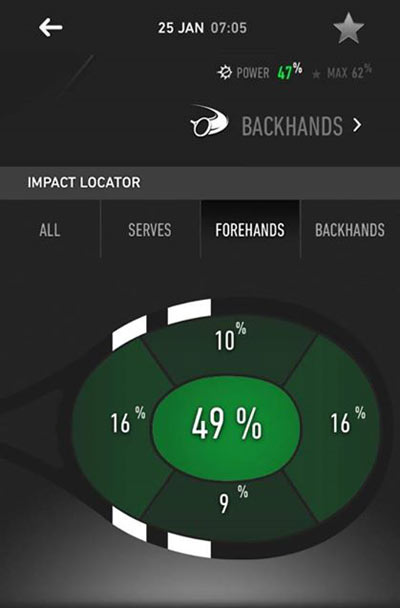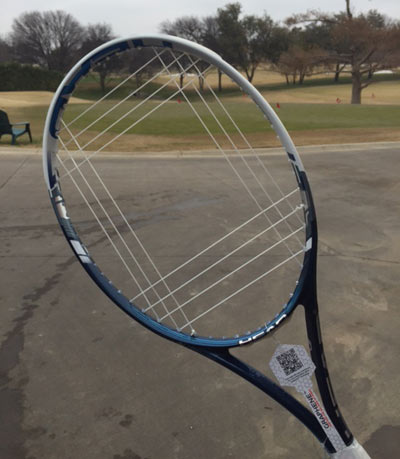|
TennisOne Lessons What is the Sweet Spot? And, how often do you hit the ball in that region? Joe Dinoffer Speculation without science to back it up drives me crazy, especially when it comes to tennis. There are so many instructions shouted across tennis nets all around the world that are not only antiquated, they are just plain wrong. Here’s a true story from years ago in Hawaii. The teacher calls out repeatedly to the student, “Watch the ball hit the strings!” After shanking the ball several times in a row, the student was very frustrated and yelled back at the teacher, “I am watching the ball!” Obviously, that teaching pro needed to take a different approach. Here’s a second fictional but typical story that happens in one tennis club or another 365 days a year. Rick takes tennis lessons from “John Doe Pro” every Saturday morning from 10-11am. Like many weekend warriors, Rick rarely has time to play during the week and looks forward to getting a workout and a few tips during his weekly Saturday morning lesson. He says be wants to improve and likes to hit with John Doe, but starts tuning out the instructions because John seems to repeat the same thing over and over and over again, week after week after … well, you get the idea. On this particular Saturday, after the lesson was over, John Doe Pro goes in the office where a couple of the club’s other teaching pros were hanging out. He shakes his head and starts complaining that he has to repeat the same instructions every single week to Rick and is getting sick of it, because Rick just can’t remember what he keeps saying from week to week. What’s the lesson to be learned from this scenario? The pro is blaming the student for his own lack of teaching skills. If you take lessons and this situation sounds familiar, read on so at least we can put to rest whether the instruction “Watch the ball hit the strings!” has a place in 21st century tennis instruction.
In this article, we will evaluate this topic in four parts.
What Does “Watch the Ball” Really Mean? Watching or tracking the ball in and of itself is not a bad instruction at all. The only use of that instruction that is just plain impossible is when tennis teachers say, “Watch the ball hit the strings.” Ball and string contact occurs in 3-4 milliseconds, a faster event than the human eye can see and identify. Since tennis is such a fast-paced sport, and where split second decisions mean the difference between winning and losing, ball tracking is a skill that needs to be developed. The confusion around this fact is because players experience the “illusion” of thinking they see the ball during its entire flight when, in fact, it is impossible. This optical illusion is called “completion phenomenon” and there are studies which argue that it is not productive to track the ball close to the racquet when trying to strike a fast moving ball. A study in France suggests that we use the term “gaze control” that would include the skill of tracking the ball, but not to the point of sudden head shifting to try and look at the point of contact. Many studies recommend that players’ top priority is to keep a steady head and that elite players develop a pattern of having and maintaining consistent gaze control, which often covers the area in space that is several feet in front of their point of contact. How Big is the Sweet Spot? Science also tells us that every racquet has three different sweet spots. But, more simply put and in a general sense, the sweet spot is the area of the string bed that produces the best combination of feel and power. For those inclined towards scientific details, here are the three types of sweet spot sensations:
If these terms are foreign to you and you want a little more detail, look them up on the internet. Did this answer the initial question about how big is the sweet spot? Not really. There are too many variables involved to easily answer this important question. The answer depends on variables including racquet design, string type, string tension, and the amount of spin you are hitting.
Determine How Often You Hit Off-Center Let’s share three ways to tell how often you hit off center. The first two use technology and require an investment. The third one is easy and by far the least expensive.
Tips to Improve Your Visual Focus
Your comments are welcome. Let us know what you think about Joe Dinoffer's article by emailing us here at TennisOne. |
 Speaking of spin, it is interesting to note that the same player hitting the ball flat or with spin can change the time the ball dwells on the strings from 3 to up to 5 milliseconds. The conclusion? The somewhat elusive “sweet spot” is the area in the middle of the racquet that feels “good” when you strike the ball. It’s that simple.
Speaking of spin, it is interesting to note that the same player hitting the ball flat or with spin can change the time the ball dwells on the strings from 3 to up to 5 milliseconds. The conclusion? The somewhat elusive “sweet spot” is the area in the middle of the racquet that feels “good” when you strike the ball. It’s that simple. 